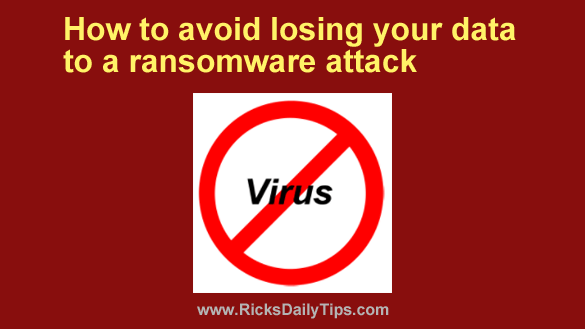 If you’ve been paying attention to the news of late, you probably know that the number of successful ransomware attacks on computers and mobile devices are increasing by the day.
If you’ve been paying attention to the news of late, you probably know that the number of successful ransomware attacks on computers and mobile devices are increasing by the day.
Ransomware is a particularly insidious form of malware that encrypts all the files on your computer or mobile device, then holds your precious data hostage until you pony up and pay a monetary ransom to the hackers.
Once ransomware has locked up your machine, you’ll have no choice except to pay the ransom or you’ll have to say goodbye to your data forever. But…
As insidious as ransomware is however, there are steps you can take to ensure that you never lose a single byte of precious data or pay the crooks a ransom to get it back.
First of all, you need to make regular backups of your data. After all, a hacker can’t hold your data for ransom in the first place if you have it all backed up and ready to restore at any time.
Backing up a Windows PC is pretty easy. All you need to do is create a new “System Image” backup once a week, once a month, or however often you deem necessary in order to safeguard your most recently created (or changed) files.
You’ll find links to instructions for creating a System Image backup in any recent version of Windows right here.
If you have an iOS device, you can easily back up your data using iCloud.
Note: While Apple has designed iOS to be quite resistant to catching viruses and other forms of malware (including ransomware), there are no guarantees.
For the reasons mentioned in this post, you don’t really need an antivirus app on your iPhone, iPad or other iOS device, but I do recommend that you take steps to back up your iOS devices. As they say, better safe than sorry.
If you have an Android device you can back up your data to your Google account.
Mac users have a plethora of backup options including the Apple’s awesome Time Machine utility, but in my opinion nothing beats the simplicity of Carbonite. Once you set it up your backups will be made automatically!
Once you have a current backup stored away you’ll no longer have to worry about losing your data to a ransomware attack. But since you’ll still have to go through the hassle of restoring all of your files, it’s best to avoid falling victim to an attack if at all possible.
Luckily, there are some things you can do to minimize the risk of a successful ransomware attack.
First, be very careful not to open any email that arrives from out of the blue, even if you know the person who supposedly sent it.
Email accounts get hacked all the time, and the hackers often use those hacked accounts to send out spam and other malicious forms of emails to all the contacts stored in the hacked email account.
What’s more, the “Sender” field of an email is easily spoofed, making it easy for hackers to send emails in a friend’s name without even having access to that friend’s account. In fact, they can even spoof your own email address and make it appear that you sent the email to yourself!
Be especially wary of emails that contain attachments, but it’s best to avoid all emails that you aren’t absolutely certain are genuine.
Unfortunately, emails aren’t the only source of ransomware these days. Some ransomware viruses are now being spread via malicious software and app downloads.
If at all possible, only download computer programs, games and apps from trusted sources. You should also limit your Android and iOS app downloads to only the ones being offered through the official Google Play Store and Apple’s iTunes.
And finally, it’s extremely important to install a quality antivirus app and keep it updated with the very latest virus definition files. Then make it a habit to run regular malware scans on all of your devices.
This post explains how to thoroughly scan your Windows PC for malware and remove any malicious code that is found.
I also recommend installing the fantastic AVG for Android app on your Android devices and Malwarebytes for Mac on all of your Apple macOS devices.
Bottom line: Ransomware is attacking computers and mobile devices like crazy these days, but performing the steps listed above will help ensure that your precious data will remain safe and sound.